Unlocking the secrets of the diverse and enchanting Pothos world can transform your home into a lush, vibrant sanctuary. If you’ve ever felt overwhelmed by the sheer number of types of Pothos plants available, or struggled to identify a particular variety, this definitive guide is your ultimate resource. We’re diving deep into over 10 distinct varieties, offering unparalleled identification tips, nuanced care instructions, and unique comparison guides that empower both novice and expert plant enthusiasts to confidently grow and cherish their Pothos collection. Prepare to master Pothos identification and care like never before!
TABLE OF CONTENTS
What Exactly is a Pothos Plant? A Foundational Overview
A Pothos plant, scientifically known primarily as Epipremnum aureum or Epipremnum pinnatum, is a beloved vining houseplant celebrated for its striking foliage and remarkable resilience. Native to the Solomon Islands, these tropical beauties thrive in various indoor environments, making them a favorite among plant parents worldwide. They are characterized by their heart-shaped leaves, vining growth habit, and incredible adaptability, often praised for their air-purifying qualities as well.
The journey of the Pothos plant from its native rainforests to our living rooms is a fascinating one. Initially discovered in the late 19th century, Pothos, often confused with Philodendron, gained significant popularity in the mid-20th century due to its ease of care and ability to thrive indoors. Its resilience and striking good looks secured its place as a household staple, evolving from a simple green vine to a diverse collection of stunning variegated pothos varieties over decades of cultivation.
Understanding Pothos Variegation & Key Characteristics
The magic of Pothos often lies in its variegation the beautiful patterns and color variations on its leaves. This phenomenon occurs due to mutations that affect the plant’s chlorophyll production, resulting in dazzling displays of gold, white, cream, silver, and neon green against a backdrop of classic green. Each type of Pothos plant boasts its own unique variegation pattern, contributing to its distinct charm.
Pothos leaves typically feature a characteristic heart shape, though some species like Epipremnum pinnatum can develop elongated or even fenestrated (split) leaves as they mature. Their growth habit is predominantly vining, capable of trailing gracefully from hanging baskets or climbing vigorously up moss poles or trellises. Understanding these key characteristics is vital for accurate identification and appreciating the individuality of each Pothos.
How to Choose the Perfect Pothos for Your Home
Selecting the ideal Pothos can be a delightful journey when you know what to look for. Beyond aesthetic appeal, several practical factors will influence which pothos plant types will thrive in your specific environment and match your lifestyle.
Consider these aspects when making your choice:
- Available Light: Some variegated varieties require brighter light to maintain their vibrant patterns, while others tolerate lower light conditions well.
- Desired Care Commitment: While generally easy-care, some rarer types might have slightly more specific needs or slower growth rates.
- Aesthetic Preferences: Do you prefer bold white variegation, subtle speckles, or a bright neon glow? Think about the leaf shape and growth habit that best complements your space.
- Pet Safety Considerations: It’s important to note that all Pothos varieties are toxic if ingested, so consider where you place them if you have curious pets.
- Suitability for Different Spaces: A cascading ‘Golden Pothos’ is perfect for a hanging basket, while a climbing ‘Cebu Blue’ could transform a vertical space.
The Comprehensive Directory of Pothos Plant Varieties (10+ Types)
This is where your Pothos identification journey truly begins. We’ve curated the most extensive list of pothos varieties, offering in-depth profiles to help you distinguish each one and understand its unique needs.
Golden Pothos (Epipremnum aureum)
The undisputed king of houseplants, the Golden Pothos is recognizable by its classic green leaves splashed with vibrant gold or yellow variegation. Highly resilient and a rapid grower, it’s the quintessential beginner-friendly plant.
- Key Points: Classic green with gold flecks, highly resilient, rapid grower, adaptable to various light conditions.
- Our Unique Angle: Did you know the Golden Pothos was one of NASA’s top 10 air-purifying plants, effectively removing toxins like formaldehyde, benzene, and xylene from indoor air? (Reference: NASA Clean Air Study).
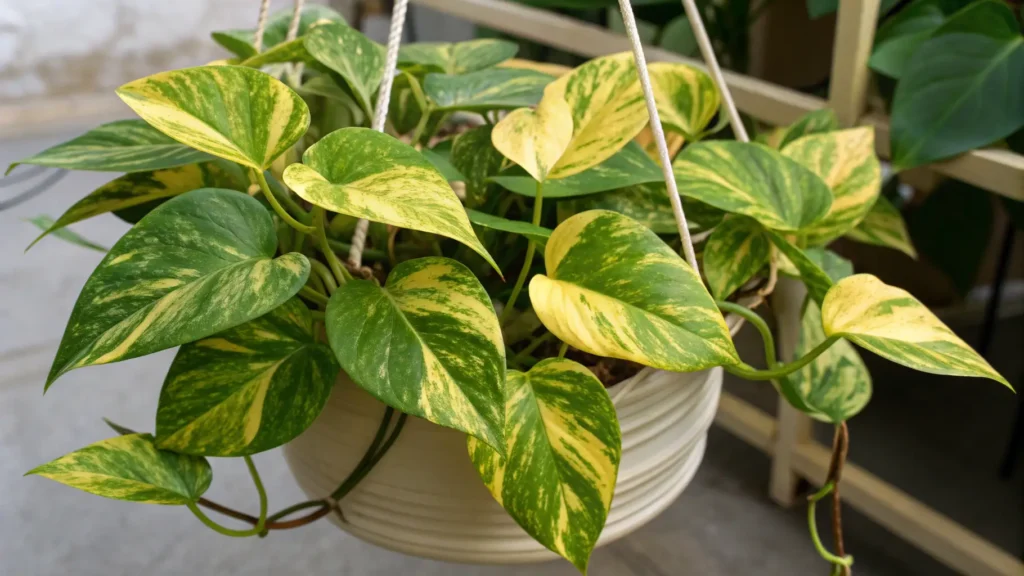
Marble Queen Pothos (Epipremnum aureum ‘Marble Queen’)
A stunning cultivar known for its heavy creamy-white variegation marbled across its green leaves. This variety demands brighter indirect light to maintain its striking white patterns, and typically grows slower than its Golden counterpart.
- Key Points: Green with creamy white variegation, requires brighter light for strong variegation, slower growth than Golden.
- Our Unique Angle: To enhance and maintain its beautiful variegation, place your Marble Queen in a spot with plenty of bright, indirect light. Less light can cause the white areas to revert to green.
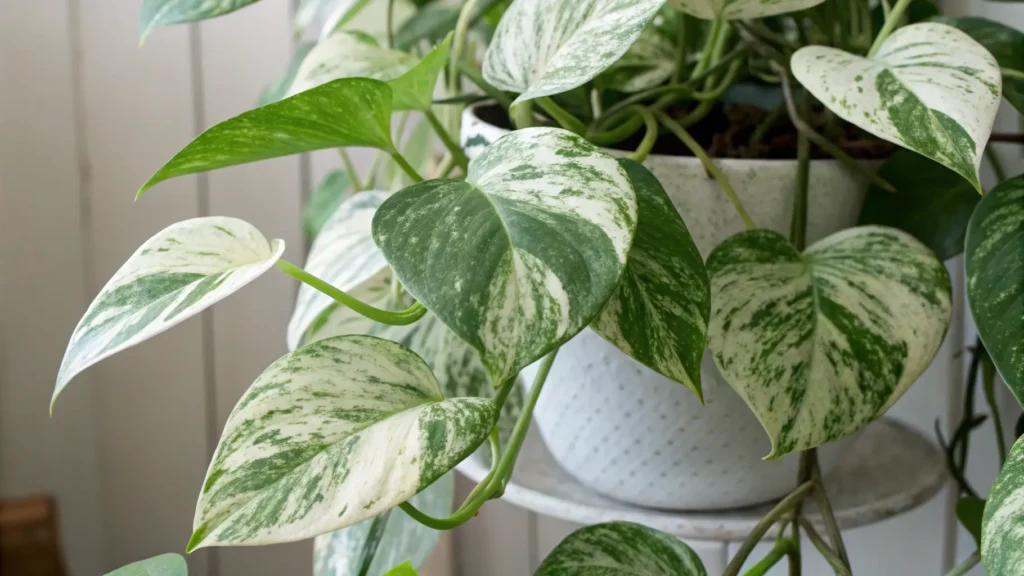
Neon Pothos (Epipremnum aureum ‘Neon’)
The Neon Pothos captivates with its brilliant, electric yellow-green leaves, making it a standout in any collection. Unlike other varieties, its charm lies in its solid, unvariegated (or very subtly variegated) bright hue. It’s sensitive to direct sun, which can scorch its vibrant foliage.
- Key Points: Bright, electric yellow-green leaves, less variegation, sensitive to direct sun.
- Our Unique Angle: Witness the “glow” of a healthy Neon Pothos! Its leaves appear to almost fluoresce, especially under ambient light, creating a truly eye-catching display.

N’Joy Pothos (Epipremnum aureum ‘N’Joy’)
The N’Joy Pothos features distinct, crisp white margins against dark green leaves, with variegation typically confined to the edges. It grows compactly and is often confused with other white-variegated Pothos due to visual similarities.
- Key Points: Dark green with distinct white margins, compact growth, a cultivar known for crisp variegation.
- Our Unique Angle: To help differentiate, compare the N’Joy’s well-defined, often blocky white patches that rarely creep into the green center, directly with the more speckled or feathered patterns of Pearl and Jade or Glacier Pothos.
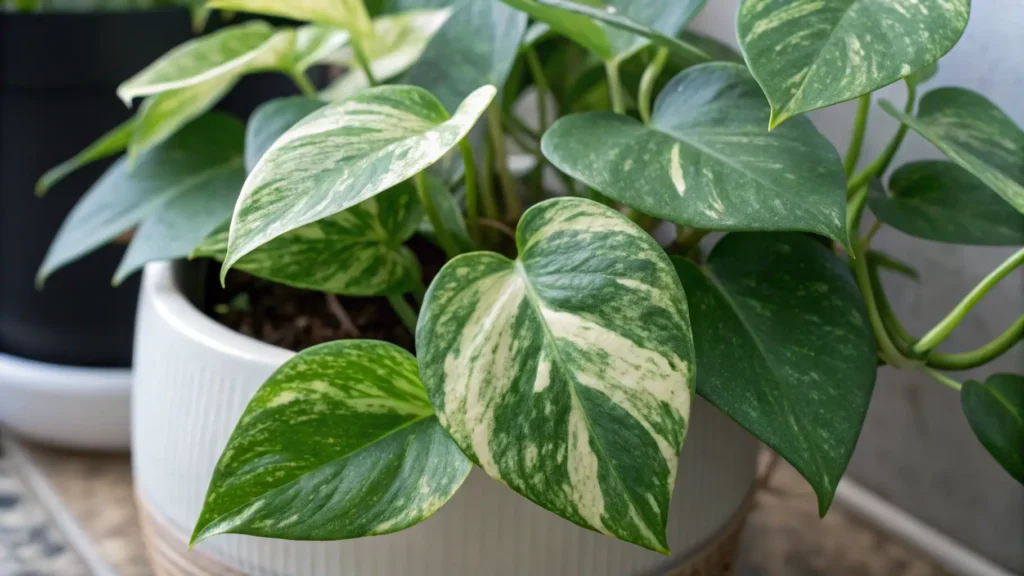
Pearl and Jade Pothos (Epipremnum aureum ‘Pearl and Jade’)
This variety exhibits a beautiful blend of green, white, and silver-gray variegation, often with small flecks of green within the white areas. Its leaves are typically smaller than N’Joy, and its variegation can appear less crisp, bleeding slightly into the green.
- Key Points: Green, white, and silver-gray variegation, smaller leaves, slightly less crisp margins than N’Joy.
- Our Unique Angle: A close inspection reveals the unique texture of Pearl and Jade leaves. The variegated areas can sometimes have a slightly different feel, and the white patches often contain tiny speckles of green, unlike the purer white of N’Joy.
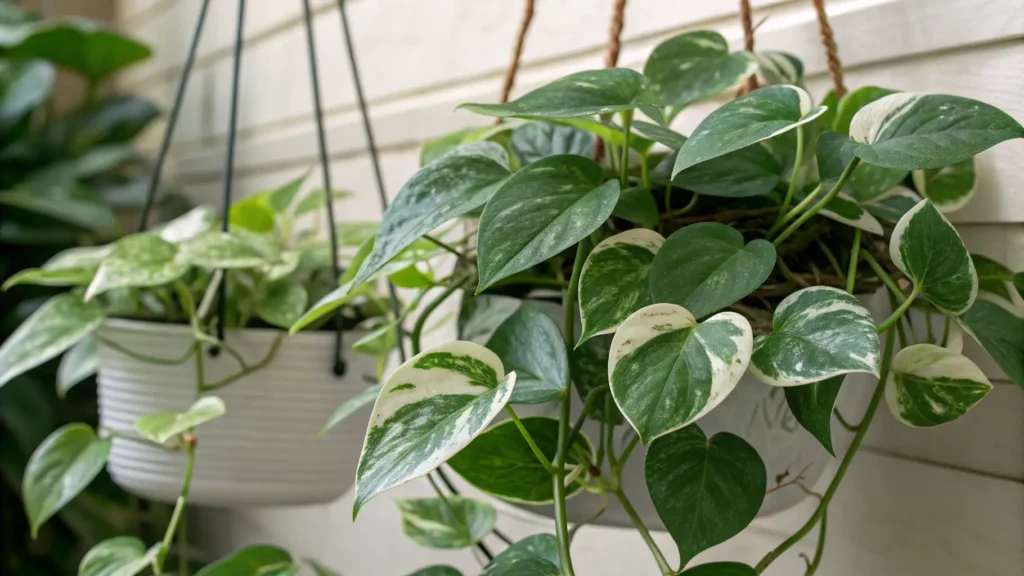
Manjula Pothos (Epipremnum aureum ‘Manjula’)
A highly sought-after and distinctive variety, Manjula Pothos is celebrated for its broad, heart-shaped leaves that often have wavy edges. Its variegation is a rich tapestry of creamy white, silver, and various shades of green, giving it a unique “painterly” or watercolor effect.
- Key Points: Broad, heart-shaped leaves, creamy white, silver, and green variegation, often described as “painterly.”
- Our Unique Angle: Grower’s Tip: To encourage those signature broad, wavy leaves and vibrant variegation, provide your Manjula with consistent bright, indirect light and consider a moss pole for it to climb. This mimics its natural growth pattern.
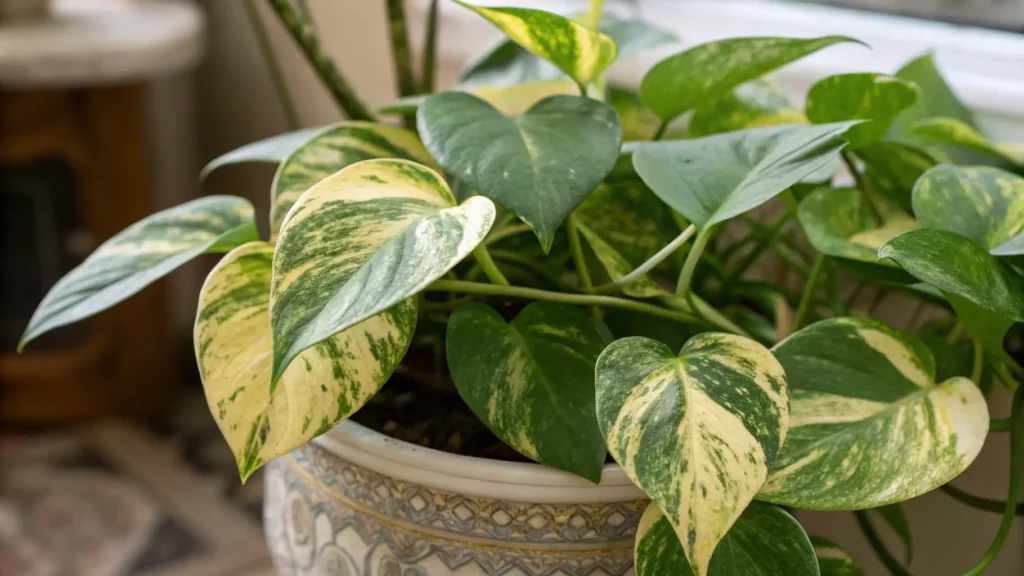
Global Green Pothos (Epipremnum aureum ‘Global Green’)
A relatively new and rapidly growing popular variety, the Global Green Pothos features vibrant emerald green centers with darker green margins. Its compact growth habit and consistent coloring make it a visually appealing and easy-to-care-for choice.
- Key Points: Emerald green center with darker green margins, compact growth, relatively new release, consistent coloring.
- Our Unique Angle: Introduced to the market relatively recently, Global Green quickly gained traction due to its unique bi-coloration and robust growth. It’s becoming more readily available in nurseries and online.

Jessenia Pothos (Epipremnum aureum ‘Jessenia’)
Similar in appearance to the Marble Queen, the Jessenia Pothos features lime green or chartreuse variegation that subtly marbles or flecks across its dark green leaves. The patterns tend to be more speckled and diffused, giving it a softer, almost watercolor look compared to the bolder blocks of white on Marble Queen.
- Key Points: Green leaves with chartreuse/lime green variegation, similar to Marble Queen but with more speckled/marbled patterns.
- Our Unique Angle: While both feature green and lighter variegation, the Jessenia’s variegation blends more smoothly into the green, almost like a subtle green ‘camouflage’, whereas Marble Queen often has more defined patches.
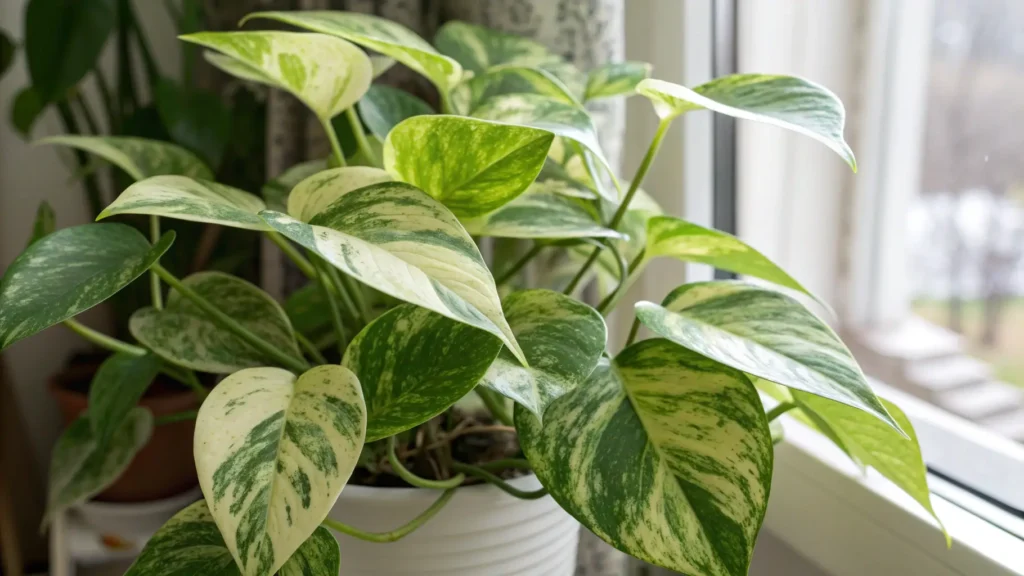
Glacier Pothos (Epipremnum aureum ‘Glacier’)
Often confused with N’Joy and Pearl and Jade, Glacier Pothos has smaller, more compact leaves. Its variegation is a mix of green, gray-green, and creamy white patches, often featuring some silvering. It’s generally less vigorous in growth compared to its larger cousins.
- Key Points: Smaller leaves, green with gray-green and white patches, less vigorous than N’Joy/Pearl and Jade, often features silvering.
- Our Unique Angle: Due to its compact size and slower growth, the Glacier Pothos is an excellent choice for smaller spaces, terrariums, or bottle gardens where you want a contained yet beautiful vining plant.
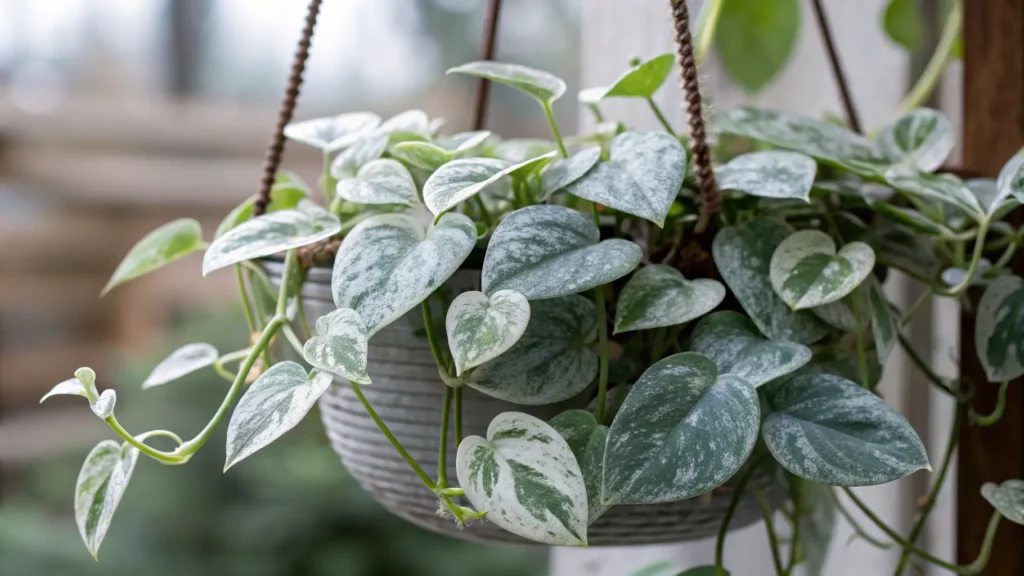
Cebu Blue Pothos (Epipremnum pinnatum ‘Cebu Blue’)
A distinct species from the more common Epipremnum aureum varieties, the Cebu Blue Pothos captivates with its elongated, silvery-blue-green leaves. Its juvenile form is elegant and unlobed, but given proper conditions and climbing support, it can develop dramatic fenestrations (splits) as it matures, mimicking a Monstera.
- Key Points: Silvery-blue elongated leaves, can fenestrate when mature, needs support to climb for mature form.
- Our Unique Angle: Observe the striking transformation! Juvenile Cebu Blue leaves are smooth and elongated, while mature leaves develop deep fenestrations, revealing its true potential.
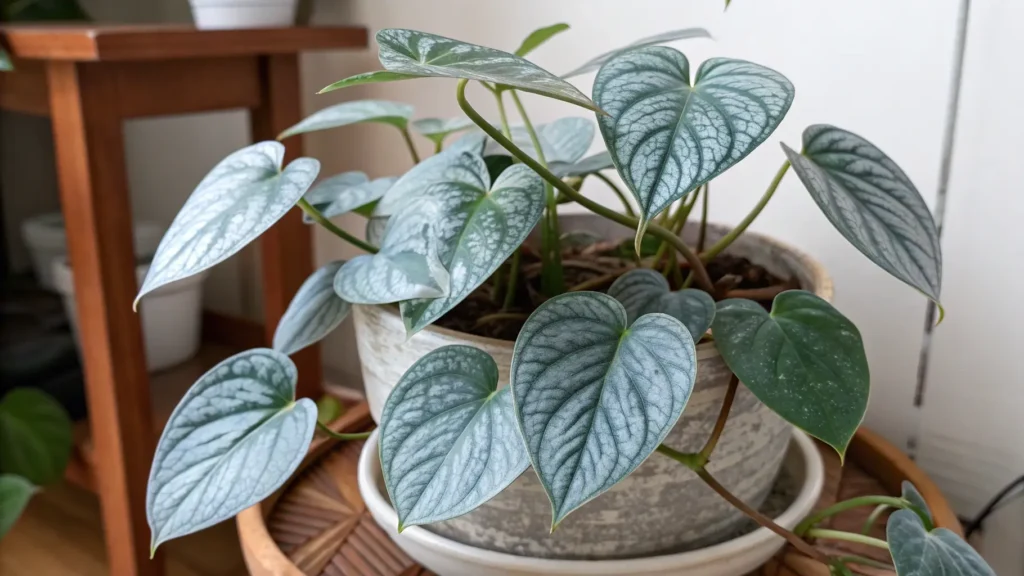
Baltic Blue Pothos (Epipremnum pinnatum ‘Baltic Blue’)
Another stunning Epipremnum pinnatum variety, the Baltic Blue Pothos boasts darker green-blue leaves than Cebu Blue, often showing deep fenestrations even in its juvenile stage. It’s a relatively fast grower and adds a dramatic, architectural element to any collection.
- Key Points: Darker green-blue leaves, deep fenestrations even in juvenile form, fast grower, requires climbing support.
- Our Unique Angle: To truly encourage the deep, dramatic fenestrations that give Baltic Blue its distinctive look, provide a sturdy moss pole or trellis for it to climb. This mimicry of its natural growth habit is key to unlocking its mature beauty.
Shangri-La Pothos (Epipremnum pinnatum ‘Shangri-La’)
The Shangri-La Pothos is a truly unique and highly textured variety that instantly grabs attention. Its dark green leaves appear “crinkled” or “shredded,” resembling tangled noodles, creating an unusual and captivating aesthetic. It’s another fascinating form of Epipremnum pinnatum.
- Key Points: Crinkled, “shredded” leaves, dark green, unusual texture, a form of E. pinnatum.
- Our Unique Angle: Get up close and personal with its unique texture! The deep crinkles and folds are not just visual; they give the leaf a distinct, almost pleated feel unlike any other Pothos.

Other Rare & Emerging Pothos Varieties
Beyond the well-known, the world of Pothos is continuously expanding with new cultivars and rare finds. This section ensures we are the most up-to-date resource on these captivating pothos plant types.
- Harlequin Pothos: A rare gem, similar to Manjula but with even more intense and unpredictable white variegation, sometimes covering almost entire leaves. Highly sought after.
- Hawaiian Pothos: A larger-leaved variant of the Golden Pothos, known for its impressively large foliage and vigorous growth when mature.
- Tricolor Pothos: An incredibly rare and distinct cultivar, displaying three colors prominently typically green, white, and a blush of pink or yellow.
- Green Jade Pothos: A classic, unvariegated variety known for its deep, glossy emerald green leaves. It’s incredibly robust and an excellent choice for low-light areas.
- Scindapsus Pictus Varieties (e.g., ‘Exotica’, ‘Argyraeus’, ‘Silvery Ann’): While technically Scindapsus pictus and not Epipremnum, these “Satin Pothos” are often grouped with Pothos due to similar care and appearance. They feature striking silver variegation.
- NJoy Jade Pothos: A less common, all-green variant of the N’Joy, offering solid green leaves with the same compact growth habit.
- Variegated Cebu Blue Pothos: An incredibly rare variant of the Cebu Blue, showcasing the signature elongated leaves with creamy or yellow variegation.
- ‘Aureum’ Pothos: This is the standard, original species often referred to as Golden Pothos when it displays its typical golden variegation, but can also describe the non-variegated green form it reverts to.
- Happy Leaf Pothos: A new introduction with small, heart-shaped leaves that are a mix of bright green and lime green, similar to Global Green but with more pronounced and vibrant lime coloration.
- Pothos ‘Snow Queen’: Often considered a heavily variegated Marble Queen, with significantly more white and cream, sometimes covering 70-80% of the leaf surface. It requires bright light to maintain this extreme variegation.
- Pothos ‘White Sport’: A specific mutation found on some Pothos where a portion of the leaf, or even an entire stem, reverts to pure white, often unstable but striking.
- Pothos ‘Emerald’: A vibrant, deep emerald green variety with a glossy finish, less common than Jade but with a richer hue.
- Pothos ‘Mint’: A rare and highly prized variety with delicate mint-green and creamy-white variegation, giving it a softer, pastel appearance.
- Pothos ‘Skeleton Key’: A truly unique Epipremnum pinnatum with deeply lobed leaves that mature into a “skeleton key” shape, creating large gaps in the foliage.
Pothos Comparison Guide: Side-by-Side for Similar Varieties
One of the biggest challenges for Pothos enthusiasts is differentiating between visually similar pothos plant types. Our unique comparison guide is designed to resolve this common confusion.
N’Joy vs. Pearl and Jade vs. Glacier
These three white-variegated Pothos are frequently mistaken for each other. Here’s how to tell them apart:
| Feature | N’Joy Pothos | Pearl and Jade Pothos | Glacier Pothos |
|---|---|---|---|
| Variegation | Crisp, well-defined white patches, rarely into green. | Green, white, and silver-gray with green flecks in white. | Green, gray-green, and white patches; more silvering. |
| Margins | Very distinct, almost blocky. | Less crisp, variegation can bleed into green. | Softer, more blended. |
| Leaf Size | Typically medium, compact growth. | Smaller, more compact leaves. | Smallest, very compact. |
| Growth Habit | Compact, less vigorous. | Moderately vigorous, somewhat bushy. | Slowest growth, ideal for terrariums |
Manjula vs. Global Green
While both feature striking green foliage, their variegation patterns are distinct.
- Manjula: Features broad, wavy leaves with splashes of creamy white, silver, and various greens. The variegation appears more diffused and “painterly.”
- Global Green: Characterized by a solid emerald green center with distinct, darker green margins. The contrast is sharper and more defined.
Cebu Blue vs. Baltic Blue
These two Epipremnum pinnatum varieties share lobed leaves but have clear distinctions.
- Cebu Blue: Silvery-blue elongated leaves; fenestrations develop primarily with maturity and climbing.
- Baltic Blue: Darker, deeper blue-green leaves; often shows fenestrations even in juvenile form, more pronounced and frequent.
Expert Pothos Care & Troubleshooting Tips (Variety-Specific Insights)
While Pothos are generally easy to care for, providing optimal conditions for each unique type of Pothos plant can make a significant difference, especially in maintaining their stunning variegation.
- Light Requirements for Optimal Variegation:
- Highly Variegated Types (e.g., Marble Queen, Snow Queen, Harlequin): Require bright, indirect light to maintain their white/yellow patterns. Low light can cause them to revert to green.
- Less Variegated/Solid Types (e.g., Neon, Green Jade, Golden): Tolerate medium to lower light, though bright indirect light will promote faster, healthier growth.
- Blue Types (e.g., Cebu Blue, Baltic Blue): Prefer bright, indirect light to maintain their distinct color and encourage fenestrations.
- Watering Cues Unique to Specific Types: Generally, Pothos prefer to dry out between waterings. However, larger-leaved varieties might need slightly more frequent watering than smaller, more compact types. Always check the top 1-2 inches of soil.
- Humidity Preferences: While tolerant of average household humidity, all Pothos appreciate higher humidity (50-70%), especially variegated and Epipremnum pinnatum types.
- Soil & Fertilizer Considerations: A well-draining potting mix is crucial. Fertilize sparingly during the growing season (spring/summer) with a balanced liquid fertilizer.
- Common Pests & Diseases: Pothos are relatively pest-resistant but can occasionally suffer from spider mites, mealybugs, or scale. Check under leaves regularly. Some highly variegated types might show more stress from environmental issues, making them seem more susceptible.
Ask the Expert: “One common issue I see with heavily variegated Pothos, like the Snow Queen or Manjula, is the browning of the white sections,” says a seasoned plant nursery specialist. “This is usually a sign of inconsistent watering, low humidity, or too much direct sunlight scorching those delicate white parts, which lack chlorophyll.”
Tackling Browning White Variegation:
- Increase Humidity: Use a pebble tray, humidifier, or mist regularly around the plant.
- Adjust Light: Move to a location with bright, indirect light. Avoid direct afternoon sun.
- Consistent Watering: Ensure the soil dries out between waterings, but don’t let it stay dry for too long.
- Check for Minerals: High mineral content in tap water can also contribute; consider filtered water if issues persist.
Pothos vs. Philodendron: A Clear Distinction
It’s a common point of confusion for new plant parents: telling the difference between Pothos and Philodendron. While both are popular vining plants with similar care needs, key anatomical differences can help you distinguish them.
- Leaf Shape: Pothos leaves are typically thicker and waxy, with a more pronounced heart shape. Philodendron leaves are often thinner, softer, and can be more elongated or have a distinct, pointed tip.
- Texture: Pothos leaves tend to be slightly more rigid and waxy, while Philodendron leaves are softer to the touch.
- Node Structure: Look at where the leaves emerge from the stem. Pothos have a single root/petiole (leaf stalk) sheath that typically dries and falls off as the leaf matures. Philodendron, conversely, has a cataphyll (a protective sheath) that encases new leaves and then dries and remains attached to the stem.
- Aerial Roots: Both have aerial roots, but Pothos roots are typically thicker and knobbier.
Frequently Asked Questions About Pothos Types
Here are answers to some of the most common questions about the diverse types of pothos plants:
- How many types of Pothos are there? There are over 10 recognized cultivars and species variants of Pothos, with new ones constantly emerging through cultivation and discovery. Our guide covers many of the most popular and rare pothos varieties.
- What’s the easiest Pothos to grow? The Golden Pothos and Green Jade Pothos are widely considered the easiest to grow due to their incredible adaptability to various light conditions and forgiving nature regarding watering.
- What’s the rarest Pothos? Rarity can fluctuate, but varieties like the Harlequin Pothos, Tricolor Pothos, and highly variegated forms of Cebu Blue are currently among the rarest and most sought-after due to limited availability and unique features.
- Are all Pothos toxic? Yes, all types of Pothos plants contain calcium oxalate crystals, which can cause irritation and swelling if ingested. Keep them out of reach of pets and small children.
- What is the fastest growing Pothos? The Golden Pothos is generally known for being the most vigorous and fastest-growing Pothos variety, especially under optimal conditions.
Where to Buy and Find Pothos Plants
Once you’ve identified your desired Pothos plant types, finding them is the next step. Thankfully, Pothos are widely available, though rarer pothos varieties might require a bit more searching.
- Online Nurseries: Many reputable online plant shops specialize in rare and common houseplants, offering a wide selection of Pothos that can be shipped directly to your door.
- Local Plant Shops & Garden Centers: Your local nurseries are excellent sources for common Pothos types and sometimes carry unique or seasonal varieties.
- Plant Swaps & Local Groups: Joining local plant communities or attending plant swaps can be a fantastic way to find unique cuttings or even full plants, often for free or trade.
- Propagation from Cuttings: If you know someone with a Pothos, they’re incredibly easy to propagate from stem cuttings in water or soil, allowing you to grow your own collection.
- Ethical Sourcing: Always strive to purchase from reputable vendors who practice ethical sourcing and sustainable growing methods.
Here’s a short list of reputable online vendors known for offering a wide range of Pothos, including rarer types, with an emphasis on ethical practices:
- Etsy (various small growers)
- Steve’s Leaves
- Gabriella Plants
- Hirt’s Gardens
The world of Pothos is rich with diversity, beauty, and rewarding growth, offering a perfect plant for every home and every plant parent.
From the common Golden Pothos to the elusive Harlequin, understanding the distinct types of Pothos plants transforms casual admiration into expert cultivation. By utilizing this ultimate guide, you are now equipped with the knowledge to identify, care for, and truly appreciate over 10 unique Pothos varieties. Dive into your collection, experiment with new additions, and watch your indoor garden flourish. Start exploring the incredible world of Pothos today your next green masterpiece awaits!
